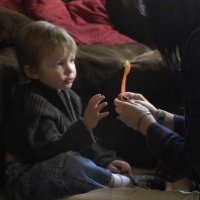Early Behavior Therapy Effective In Treating ADHD Prior To Medication
According to new research, early intervention, behavior therapy is more effective at treating the symptoms of ADHD, prior to the use of prescription medication, such as Ritalin or Adderall. A study published Thursday in the Journal of Clinical Child & Adolescent Psychology finds that symptoms of ADHD are mitigated faster if early behavior therapy is implemented prior to the use of any prescription drugs. The yearlong study looked at 146 children ages 5 to 12 who had an ADHD diagnosis.
Oftentimes, once a diagnosis is made and the severity of symptoms is determined, clinicians will opt to prescribe one of these drugs, as they have been effective in alleviating some of the challenges inherent to ADHD. The diagnostic criteria for ADHD are far-reaching, but include:
- Inattention, including often fails to give close attention to details or makes careless mistakes in schoolwork, at work, or with other activities; often has trouble holding attention on tasks or play activities; often does not seem to listen when spoken to directly; often does not follow through on instructions and fails to finish schoolwork, chores, or duties in the workplace (e.g., loses focus, side-tracked); often has trouble organizing tasks and activities; often avoids, dislikes, or is reluctant to do tasks that require mental effort over a long period of time (such as schoolwork or homework); often loses things necessary for tasks and activities (e.g. school materials,pencils, books, tools, wallets, keys, paperwork, eyeglasses, mobile telephones); is often easily distracted; is often forgetful in daily activities.
- Hyperactivity and Impulsivity, including often fidgets with or taps hands or feet, or squirms in seat; often leaves seat in situations when remaining seated is expected; often runs about or climbs in situations where it is not appropriate (adolescents or adults may be limited to feeling restless); often unable to play or take part in leisure activities quietly; is often "on the go" acting as if "driven by a motor"; often talks excessively; often blurts out an answer before a question has been completed; often has trouble waiting his/her turn; often interrupts or intrudes on others (e.g., butts into conversations or games).
- Several inattentive or hyperactive-impulsive symptoms were present before age 12 years.
- Several symptoms are present in two or more setting, (such as at home, school or work; with friends or relatives; in other activities).
- There is clear evidence that the symptoms interfere with, or reduce the quality of, social, school, or work functioning.
- The symptoms are not better explained by another mental disorder (such as a mood disorder, anxiety disorder, dissociative disorder, or a personality disorder). The symptoms do not happen only during the course of schizophrenia or another psychotic disorder.
In this study, outcomes across each of these symptoms were significantly better for those who started with the early behavior therapy rather than those who started with medication. If medications were necessary as a secondary treatment for children with more severe ADHD symptoms, lower doses were required than the typical prescribed dosage. Furthermore, a second study published in the same journal looked at cost-effectiveness across various treatments and found that behavior therapy ended up costing approximately $700 less than the group who only took medication.
The results of this study are consistent with research which has found that early intervention behavior therapy is effective at treating the symptoms of developmental delays such as autism, Down syndrome and ADHD. Behavior treatment for symptoms of ADHD will vary depending on each child's needs, but can include targeting social skills and attending to various activities in the absence of the aforementioned behaviors.
For example, if a child has difficulty sitting and attending to a 30 minute long classroom activity, a behavior analyst may determine that they attend for an average of 5 minutes before disengaging. They will then have the child attend to the classroom activity for 5 minutes (or less), and offer a break, or other preferred reinforcer, contingent upon engaging in the classroom task and the absence of any target behaviors, then reintegrate back into the classroom activity. This time will gradually be increased with success, with the ultimate goal of fading out behavioral support entirely.
While every single child develops in a unique fashion, regardless of whether they have a diagnosis or not, the difference lies in whether the symptoms together limit and impair everyday functioning. Behavior therapy, or applied behavior analysis, seeks not to strip a child of their personality and conform them to societal norms, but rather to help children integrate into various settings in their daily life, such as their classroom, a play date or their family's dinner table.
Article written by:
Pasha Bahsoun, M.A., BCBA, earned a Bachelor's of Science in Psychobiology from UCLA and a Master of Arts in Developmental Psychology from Teachers College, Columbia University, where he researched and implemented various approaches to educating children diagnosed with autism, including through social skills training and the use of educational media. Pasha’s thesis was titled, “The Use of Educational Media with Children Diagnosed with Autism,” in which he worked with the PBS television show “Super Why!” to develop games and programs catering to the developmentally disabled. Pasha currently serves as the Director of Social Skills, BCBA Supervisor at the Center for Applied Behavior Analysis.









Comments